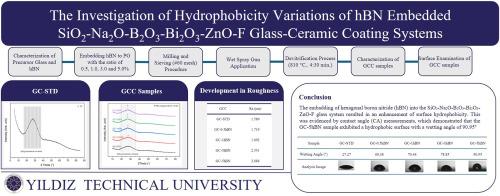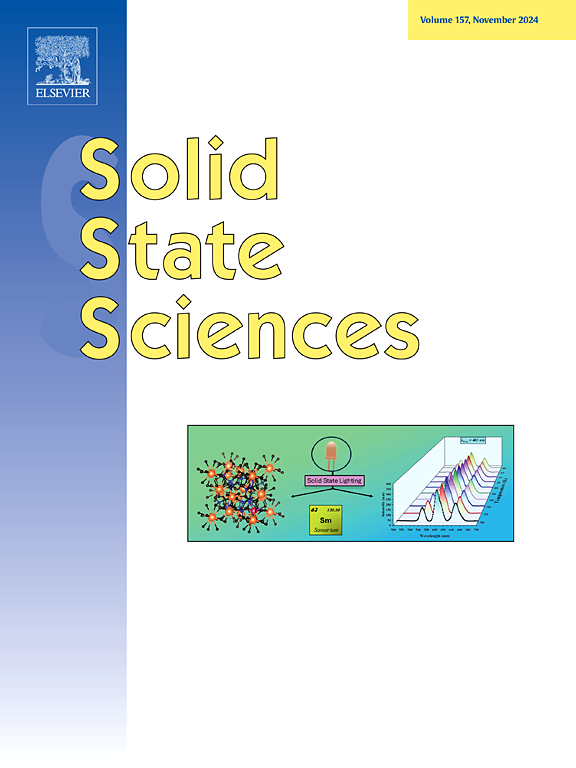hbn包埋SiO2-Na2O-B2O3-Bi2O3-ZnO-F玻璃陶瓷涂层体系疏水性变化研究
IF 3.3
3区 化学
Q2 CHEMISTRY, INORGANIC & NUCLEAR
引用次数: 0
摘要
研究了六方氮化硼(hBN)添加剂对玻璃陶瓷涂层(GCCs)疏水性和表面形貌的影响。用不同浓度的hBN(0%、0.5%、1.0%、3.0%和5.0%)研磨了由SiO2-Na2O-B2O3-Bi2O3-ZnO-F组成的前驱体玻璃(PG)体系。将得到的浆料湿喷涂到金属基板上,然后在810°C下进行4.5分钟的反硝化。涂层的x射线衍射(XRD)分析证实了hBN结晶度在玻璃基体中的成功结合。非接触式光学轮廓测量(NCOP)显示,随着hBN含量的增加,表面粗糙度(Ra)从1.58 μm增加到2.89 μm,而地形图显示表面高度变化(Δh)从20 μm增加到45 μm。扫描电镜(SEM)进一步证实了这些结果,表明随着hBN含量的增加,表面粗糙度逐渐增加。未改性的GCC表现出光滑均匀的形貌,而含有hBN的涂层,特别是在5 wt%时,表现出更粗糙、更不均匀的表面形貌。这些观察到的微观结构变化与NCOP和接触角测量结果密切相关。接触角(CA)分析表明,疏水性显著增强,从未修饰的GCC的27.27°增加到最高hBN浓度下的90.95°。这些发现共同表明,将hBN加入到gc中可以有效地提高表面粗糙度和疏水性,从而为各种工业应用提供了巨大的潜力。本文章由计算机程序翻译,如有差异,请以英文原文为准。

Investigation of hydrophobicity variations in hBN-Embedded SiO2-Na2O-B2O3-Bi2O3-ZnO-F glass-ceramic coating systems
This study investigates the effect of hexagonal boron nitride (hBN) additives on the hydrophobicity and surface morphology of glass-ceramic coatings (GCCs). A precursor glass (PG) system composed of SiO2-Na2O-B2O3-Bi2O3-ZnO-F was milled with varying hBN concentrations (0 %, 0.5 %, 1.0 %, 3.0 %, and 5.0 %). The resulting slurries were wet-sprayed onto a metal substrate and subsequently devitrified at 810 °C for 4.5 min. X-ray Diffraction (XRD) analysis of the coatings confirmed the successful incorporation of hBN crystallinity within the glassy matrix. Non-contact optical profilometry (NCOP) revealed that surface roughness (Ra) increased from 1.58 μm to 2.89 μm, while topographic mapping showed an increase in surface height variation (Δh) from 20 μm to 45 μm as hBN content increased. Scanning Electron Microscopy (SEM) further corroborated these results, demonstrating a progressive increase in surface roughness with higher hBN content. The unmodified GCC exhibited a smooth and uniform morphology, whereas coatings with hBN, particularly at 5 wt%, displayed a rougher, more heterogeneous surface topography. These observed microstructural changes closely aligned with NCOP and contact angle measurements. Contact angle (CA) analysis demonstrated a notable enhancement in hydrophobicity, with values increasing from 27.27° for the unmodified GCC to 90.95° at the highest hBN concentration. These findings collectively demonstrate that incorporating hBN into GCCs effectively enhances surface roughness and hydrophobicity, thereby offering significant potential for various industrial applications.
求助全文
通过发布文献求助,成功后即可免费获取论文全文。
去求助
来源期刊

Solid State Sciences
化学-无机化学与核化学
CiteScore
6.60
自引率
2.90%
发文量
214
审稿时长
27 days
期刊介绍:
Solid State Sciences is the journal for researchers from the broad solid state chemistry and physics community. It publishes key articles on all aspects of solid state synthesis, structure-property relationships, theory and functionalities, in relation with experiments.
Key topics for stand-alone papers and special issues:
-Novel ways of synthesis, inorganic functional materials, including porous and glassy materials, hybrid organic-inorganic compounds and nanomaterials
-Physical properties, emphasizing but not limited to the electrical, magnetical and optical features
-Materials related to information technology and energy and environmental sciences.
The journal publishes feature articles from experts in the field upon invitation.
Solid State Sciences - your gateway to energy-related materials.
 求助内容:
求助内容: 应助结果提醒方式:
应助结果提醒方式:


